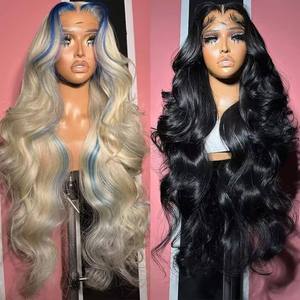
All categories
Featured selections
Trade Assurance
Buyer Central
Help Center
Get the app
Become a supplier

(178473 products available)


































There are different types of Indian hair available in the market. Each of them differs in quality and texture. The following are the main types of how much is Indian hair:
Silk top
Indian silk top wigs are known for their high quality. They have a silk top base that gives a realistic scalp appearance. The hair is hand-tied on the silk fabric, making it easy to part in any direction. This adds to the wig's overall realism. The silk closure also hides knots, giving the illusion that the hair grows directly from the scalp. These features make silk top wigs look natural and undetectable when worn.
Lace frontals
Indian hair lace front wigs have a sheer lace material attached at the front. This lace, when trimmed to fit, creates a flawless hairline appearance. The individual strands are knotted at the lace, which makes it look like the hair is growing from the edges of the face. It allows the wearer to style the wig, including pulling the hair back. The rest of the wig will have a stretch cap for a snug fit. Lace front wigs offer a natural-looking hairline.
U-part wigs
U-part wigs have a U-shaped opening at the front or top. This opening allows the wearer's natural hair to blend with the wig. Indian hair U-part wigs provide a realistic look and easy installation. They can be secured with clips or combs to stay in place. The U-part design offers versatility in styling options. It can be worn with natural hair parted in the middle or to the side. This wig creates a seamless blend with the natural hair for added length and volume.
Clip-in extensions
Indian clip-in hair extensions are popular for adding temporary length and volume. They consist of several small wefts of hair with a clip attached. To use them, one simply opens the clips and attaches them close to the roots of the hair before pinching the clips shut to lock them in place. The clips grip the natural hair securely. Indian clip-in extensions can be easily taken in and out as desired. They require no special glue, fusion, or weaving attachment.
Full lace wigs
Indian hair full lace wigs have a cap made entirely of lace. This delicate lace forms the entire base of the wig. It offers the most styling versatility. With the entire perimeter made of lace, all the hair strands are double-knotted at the lace. This allows the wearer to part the hair anywhere on the scalp for a realistic look. The lightweight lace cap also provides comfort and breathability when worn. Adjustable hooks inside the cap enable a custom fit.
Indian hair can be used in many ways. From adding extensions to braids and weaves, people have different preferences. There is no set way to use the hair. It all depends on the individual's needs and stylistic choices.
As for safety, Indian hair is a natural product. It does not contain synthetic materials that could irritate the scalp or skin. However, users should be careful with the products they use on the hair. Some chemicals can be too harsh and cause damage. It is best to avoid products with sulfates and other strong chemicals. They strip hair of its natural oils and cause dryness.
The hair should also be detangled gently to avoid breakage. Using a wide-tooth comb or fingers to untangle any knots is best. Starting from the tips and working up to the roots is good.
Additionally, the hair should be washed regularly to remove product buildup and maintain hygiene. However, washing too frequently can cause it to dry out. Only use a mild shampoo formulated for natural hair to wash the strands.
Q1: How much does Indian hair cost?
A1. The price of Indian hair varies depending on the type, quality, length, and quantity purchased. Wholesale buyers can expect to receive better deals on all Indian hairs from suppliers.
Q2: Do suppliers offer discounts on bulk orders?
A2. Yes, most suppliers offer discounts on bulk orders. The discount varies from one supplier to another. Some may offer a fixed percentage discount, while others adjust the price per unit. Either way, business buyers will benefit from the attractive wholesale rates that suppliers offer.
Q3: How do different Indian hair types affect the price?
A3. Different Indian hair types have unique characteristics that affect their pricing. For example, virgin Indian hair is unprocessed and of the highest quality, so it will cost more. On the other hand, processed Indian hair goes through some treatment and is more affordable. Other factors that affect the pricing include the length of the hair and the quantity in each bundle.
Q4: Do longer hair extensions cost more?
A4. Yes. In most cases, the longer Indian hair extensions cost more. This is because longer extensions require more donor hair to make them. Additionally, longer Indian hair is more sought after, increasing its demand and, consequently, the price.
Q5: How can buyers determine the quality of Indian hair before buying?
A5. The best way to determine the quality of Indian hair is by asking for samples. Most suppliers will provide samples that business buyers can examine before making the final purchase. In addition, buyers should look at the hair's texture, shine, and elasticity. They should also check if the hair has any chemical impurities or artificial additives.